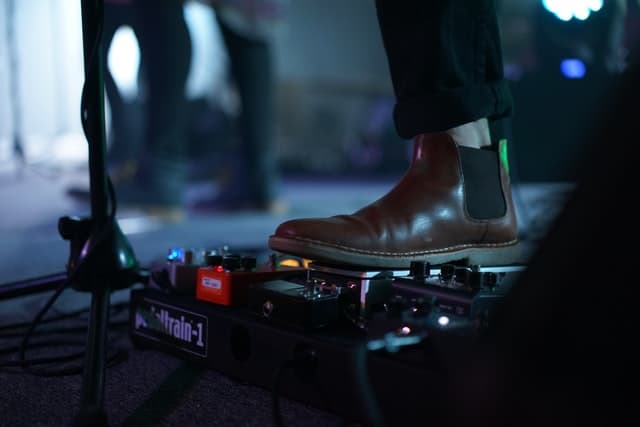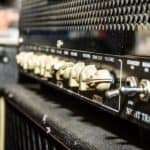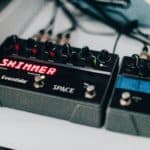Guitar pedals have gone through a major phase of development over the past couple of decades, offering a plethora of choices for the consumer.
Arguably one control that we’re seeing more and more often that arguably has the biggest impact on the overall sound of the effect is the blend/mix knob.
A blend/mix knob on a guitar effects pedal allows you to combine the processed signal with the clean one. You can achieve clearer tones, and improved sound while retaining attack and bite by skillfully using this control, or the alternatives available to add this functionality to your setup.
So, let’s chain up these effects and dive in!
What kinds of pedals do have a blend/mix knob?
Blend knobs are becoming more and more common on different kinds of effects pedals over the past few years.
For compressors, you can find them on the Keeley Compressor Plus or the JHS Pulp n’ Peel.
They can also be found on various distortions, overdrives, and fuzzes such as the EHX Nano Overlord, the JHS Moonshine V2, and the Catalinbread GIYGAS Fuzz.
They are also common on several modulation and time-based effects, such as Strymon’s Timeline and BigSky, or the Providence Anadime ADC-4.
What do blend/mix knobs do on pedals?
Essentially, a blend/mix knob (hereafter B/M for short) allows you to balance the amount of an effect (the “wet” sound) against your guitar’s original signal (the “dry” sound), offering greater control over your overall sound.
Think of it this way: When recording in a studio, some of your effects (such as delays and reverbs) may be on their own faders, rather than on the original guitar sound, allowing you to blend and balance the two.
What the B/M knob on your pedal offers is a way to achieve those results in your regular setup.
It should be important to note that some pedals, such as the TC Flashback delay, have a Level knob, which does the same thing as a B/M knob (in controlling the volume of the effect against the dry signal).
This is not the same as the Level control on pedals such as overdrives and distortions, which act more like a volume knob for the overall signal.
Best to read your pedal’s literature to see what the Level knob on your pedal does.
What’s the point of blending an effect instead of it just being on and off?
B/M knobs offer you a chance to use an effect, and not have it overpower the attack and tone of the instrument.
This can be especially useful for bass players, allowing the bass’ natural sound, attack, and low end to be maintained when using very overwhelming effects, such as fuzz.
This use can also be especially useful for keyboard players, allowing the keyboard’s sound to be retained over the effect.
Compare this to an effect that is 100% on. If you have a fuzz that is really gnarly, you can lose a lot of attack and definition over the gobs of gain that the pedal is spitting out.
Using a B/M knob allows that articulation to come back into the sound, while still having the fuzziest-of-fuzzes going on.
Say you have a lovely chorus effect that, if up at 100%, may prove to be a bit too much. If your pedal is equipped with a B/M knob, you’re able to dial in the right amount of the effect against your original signal.
This may give you a more satisfying result.
What is the best setting for a blend/mix knob on a pedal?
The best setting is really up to your personal taste, depending on the effect.
If you’re using a mid to high-gain distortion or fuzz, just dialing the mix back a bit to bring some of the original signal back in may restore some attack and clarity to your sound.
If you’re using delays or reverbs, best to start at 50% blend to see how it sounds. If you want the effect more in the background, add more of the clean signal.
If you want something more ambient which puts the effect front and center, crank up the knob to remove more of the dry signal.
However, the best setting depends on your taste; turn knobs and listen for when the sound is satisfactory to you. Voilà!
Is there a way of blending your effects in if they don’t have mix knobs?
Thankfully, with pedals and pedalboard technology evolving over the past few years, there are now solutions available to you if you don’t have a B/M control.
If your amplifier is equipped with a parallel effects loop, that offers a blending solution effects run through it.
A parallel effects loop basically maintains the dry signal of the guitar and amp, and blends in the effects in the loop as a whole using some sort of mix control.
It is important to note that you won’t have control of individual pedals, but the chain as a whole.
You may need to further tweak your pedals to balance the levels that you want. In many cases like this, the blend knobs on some of the effects are best set to 100% wet, eliminating the guitar’s signal, which will be preserved in the loop based on its parallel design.
Note that this is also different from a series-style effects loop, which basically turns your amplifier’s preamp into an in-line effect in your chain, much like regular pedals.
Now, we know that time-based effects work best in the loop, while things like compressors, distortion, etc. work best in front of an amp.
What to do there? Well, there are in-line mixing solutions available for just such as thing
Another solution is to use an in-line mixer on your pedalboard, such as Radial’s Mix-Blender, the EHX Switchblade Pro, or the Tri-Parallel mixer.
These will allow you to blend in pedals so that you can strike that balance between the effect and your original signal.
So blend and tweak away! You’ll be surprised by the sounds you may come up with!

Hello there, my name is Ramiro and I’ve been playing guitar for almost 20 years. I’m obsessed with everything gear-related and I thought it might be worth sharing it. From guitars, pedals, amps, and synths to studio gear and production tips, I hope you find what I post here useful, and I’ll try my best to keep it entertaining also.





